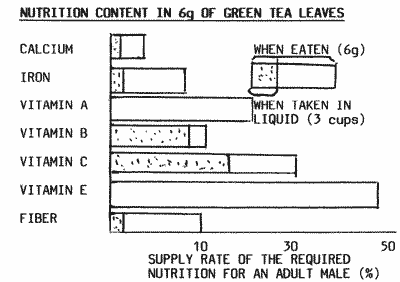
GREEN TEA MORE THAN A HEALTH DRINK
SCIENTIFIC NAME: Camellia sinensis
FAMILY: Theaceae
Drinking green tea brings health and longevity, wrote Eisai, founder of Buddhism's Rinzai sect. That was back in the early 13th century when green tea was valued for its medicinal qualities.
Today Kazutami Kuwano, assistant professor at Tokyo Kasei Gakuin Junior College, takes this idea one step further - why not eat the leaves used to make Japan's most popular drink?
The nutritional properties in green tea can prevent or cure diabetes, constipation, hemorrhoids, diarrhea, the common cold, aging and other health problems.
The caffeine in the tea helps relieve mental and physical fatigue, while the theanine, particular to green tea, counteracts the negative effects of caffeine.
Green tea is also good for preventing bad breath. Tannin, which gives green tea its yellow colour, has sterilizing powers and works against the leftover particles of food that can lead to halitosis. Lotte Company Ltd uses green tea leaves in making Clorets, the gum known for killing bad breath.
According to Kuwano, black and oolong teas are much poorer in nutritional value because their leaves lose ingredients like chlorophyll in the fermentation process. His experiments also show that black tea actually reduces the weight of rat embryos.
Among the beneficial attributes of tea, Kuwano singled out the power of green tea to prevent cancer and reduce fat as the most remarkable.
Kuwano's experiments on rats show that the catechin (which gives tea its puckery taste) and vitamins in green tea create unfavorable environments for the development and growth of tumors.
Vitamin C also quickens the oxidation and discharge of cholesterol. Sencha and gyokuro, high-quality green tea, are especially rich in vitamin C.
The catechin in green tea might also help to cure AIDS, a cancer center in Aichi announced in a March report.
"There are, however, nutrients that cannot be ingested in the form of tea." According to Kuwano, vitamin A and E are lost as they are not water-soluble.
The intake of calcium, iron, vitamin C and fiber is halved by the time the leaves are imbibed as tea. "In making three cups of green tea we use, on average, 6 grams of tea leaves. If we ate that amount of tea leaves every day, just a teaspoon at each meal, we would ingest 50 percent of the vitamin E and 20 percent of the vitamin A required in the daily calorie intake of an adult male. Tea leaves have almost no calories, though." Kuwano said.
He explained that 10 times the nutritives in raw tea leaves are packed into dried leaves of the same weight.
According to Kuwano: "We also have tea leaves from Matcha, powdered tea used in the tea ceremony. But recently matcha is grown in the shade with the result that its vitamin C is one-fourth and its vitamin E is one-half the amount in green-tea leaves."

"I like to have powdered tea leaves sprinkled on rice. That's my favourite." said the assistant professor. In order to eat the tea leaves, they must first be ground in a mill. Kuwano said the mills used for sesame seeds will do just fine. Then the powdered green tea leaves can be dusted on or mixed with almost any dish - natto, tofu, tempura, salad, sandwiches, hamburger steaks, spaghetti, fried chicken and more.
"The secret is to sprinkle the leaves on the dish right before eating. In the case of juicy foods, leaves should be soaked for a while beforehand," he said.
An elementary school in Ikebukuro, Tokyo, serves pupils dishes sprinkled with green-tea leaves twice a month. "Seventy-six percent of the pupils said the dishes were good. One-fourth of the students said they did not notice the taste of the leaves. Obviously we can see the green colour, but we can hardly detect any taste," Kuwano said.
"I eat tea leaves every day at every meal," said Kuwano. For potential tea-leaf lovers, edible powdered tea leaves will be sold beginning in May by Yamaei Co. Ltd.
DATE: May 1993
* * * * * * * * * * * * *
